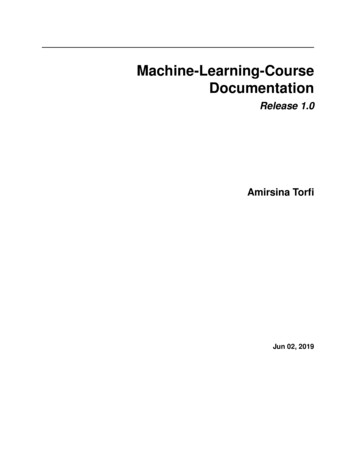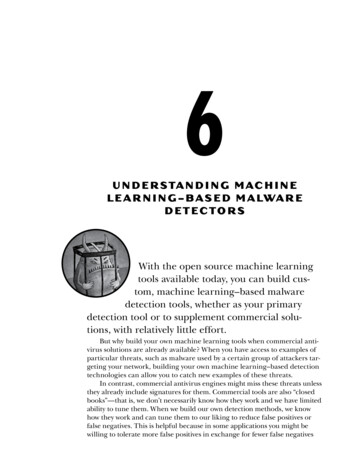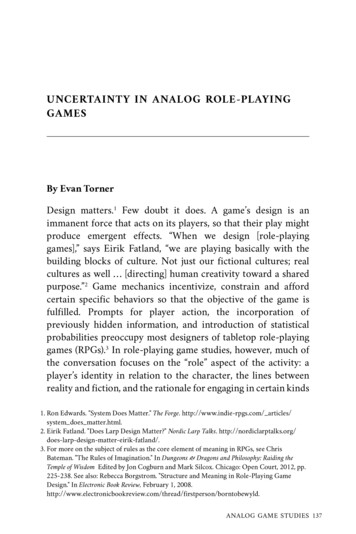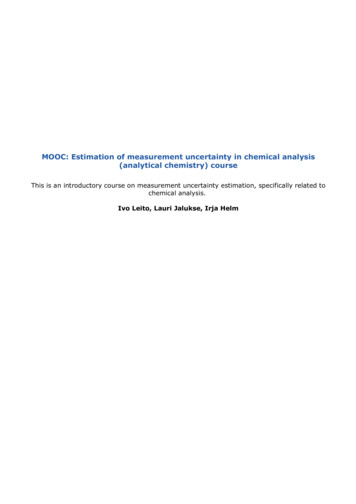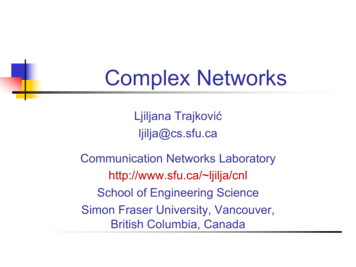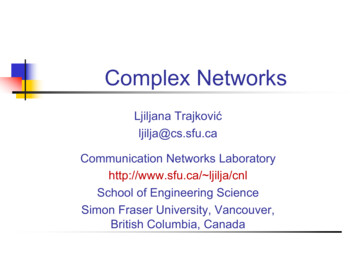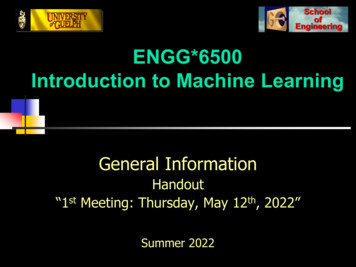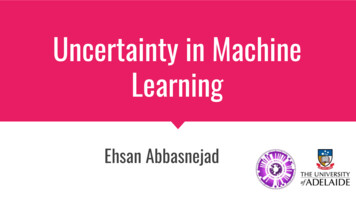
Transcription
Uncertainty in MachineLearningEhsan Abbasnejad
What is uncertainty in machine learningWe make observations using the sensors in the world (e.g. camera)Based on the observations, we intend to make decisionsGiven the same observations, the decision should be the sameHowever, The world changes, observations change, our sensors change, theoutput should not change! We’d like to know how confident we can be about the decisions
Why Uncertainty is important?Medical diagnostics
Why Uncertainty is important?Imagine you are designing the vision system for an autonomous vehicle
Why Uncertainty is important?Applications that require reasoning in earlier stagesIApply brakePedestrian detectionPimage understandingB
What is uncertainty in machine learningWe build models for predictions, can we trustthem? Are they certain?
What is uncertainty in machine learningMany applications of machine learning depend on good estimationof the uncertainty: Forecasting Decision making Learning from limited, noisy, and missing data Learning complex personalised models Data compression Automating scientific modelling, discovery, and experimentdesign
Where uncertainty comes from?Remember the machine learning’s objective: minimize the expected lossUncertainty in data(Aleatoric)Uncertainty in the model(Epistemic)When the hypothesis function class is “simple” we can buildgeneralization bound that underscore our confidence in average prediction
Where uncertainty comes from?Alternatively, the probabilistic view:Uncertainty in data(Aleatoric)Which is,Uncertainty in the model(Epistemic)
WHAT IS A NEURAL ral network is a parameterized functionUse a neural network to model the probabilityParameters θ are weights of neural net.Feedforward neural nets model p(y x, θ)as a nonlinear function of θ and x.Samples from the truedistribution are the observations:xMultilayer / deep neural networks model the overall function as acomposition of functions (layers).Usually trained to maximise likelihood (or penalised likelihood).
Point Estimate of Neural Nets: Maximum likelihoodEstimate (MLE) The weights are obtained by minimizing the expected loss It assumes the state of the world is realized by a “single” parameter We assume the samples of observations are independentI’ll use “minimizing loss” and “maximizingthe likelihood” interchangeably.
DEEP LEARNINGDeep learning systems are neural network models similar to thosepopular in the ’80s and ’90s, with: Architectural and algorithmic innovations (e.g. many layers,ReLUs, better initialisation and learning rates, dropout, LSTMs, .) Vastly larger data sets (web-scale) Vastly larger-scale compute resources (GPUs, cloud) Much better software tools (PyTorch, TensorFlow, MxNet, etc) Vastly increased industry investment and media hype
LIMITATIONS OF DEEP LEARNINGNeural networks and deep learning systems give amazingperformance on many benchmark tasks, but they are generally: Very data hungry (e.g. often millions of examples)Very compute-intensive to train and deploy (cloud GPU resources)Poor at representing uncertaintyEasily fooled by adversarial examplesHard to optimise: non-convex choice of architecture, learningprocedure, initialisation, etc, require expert knowledge andexperimentation
LIMITATIONS OF DEEP LEARNINGNeural networks and deep learning systems give amazingperformance on many benchmark tasks, but they are generally: Uninterpretable black-boxes, lacking in transparency, difficult to trustHard to perform reasoning withAssumed single parameter generated the data distributionProne to overfitting (generalize poorly)Overly confident prediction about the input (p(y x, θ) is not theconfidence!)
These networks can easily be fooled!Adding a perturbation to images causethe natural images to be misclassified.Moosavi-Dezfooli et al., CVPR 2017
OptimizationGradient descent is the method we usually use to minimize the lossIt follows the gradient and updates the parametersGradient with respect tothe full training setLearning rate(step size)
OptimizationFor large neural networks with a large training set, computing the gradientis costly.Alternatively we “estimate” the full gradient with samples from thedatasetCalled stochastic gradient descent
Updating the networkCompute iddenunitsinputsx(Update weights)y(Fixed weights)y
Using stochastic gradient descent is not ideal!When minimizing the loss, we assume the landscape is smooth .
Using stochastic gradient descent is not ideal!However the real loss landscape isVGG-56VGG-110ResNet-56Hao Li et al., NIPS, 2017
Using stochastic gradient descent is not ideal!Stochastic Gradient Descent (SGD) is a Terrible OptimizerSGD is very noisy, and turns the gradient descent into a random walk overthe loss.However, it’s very cheap, and cheap is all we can afford at scale.
Types of UncertaintyAleatoric: Uncertainty inherent in the observation noiseEpistemic: Our ignorance about the correct model that generated the dataThis includes the uncertainty in the model, parameters, convergence
ExampleKendel A., Gal Y., NIPS 2017
Types of UncertaintyAleatoric: Uncertainty inherent in the observation noiseData augmentation: add manipulated data to training set
Types of UncertaintyAleatoric: Uncertainty inherent in the observation noiseEnsemble methods, e.g.1. Augment with adversarial trainingMinor change to theinput2. Encourageto be similar to3. Train M models as an ensemble with random initialization4. Combine at test for prediction
Types of UncertaintyAleatoric: Uncertainty inherent in the observation noiseEnsemble methods
Types of UncertaintyAleatoric: Uncertainty inherent in the observation noiseEpistemic: Our ignorance about the correct model that generated the dataThis includes the uncertainty in the model, parameters, convergence
Bayesian MethodsWe can’t tell what our model is certain aboutWe utilise Bayesian modeling Bayesian Modeling addresses two uncertainties
BAYES RULEWe have a prior about the worldWe update our understanding of the world with the likelihood of eventsWe obtain a new belief about the world
BAYES RULEP(hypothesis data) P(hypothesis)P(data hypothesis) hP(h)P(data h) Bayes rule tells us how to do inference abouthypotheses (uncertain quantities) from data(measured quantities). Learning and prediction can be seen as formsof inference.Reverend Thomas Bayes (1702-1761)30 /
BAYES RULEP(parameter data) P(parameter)P(data parameter) P(θ)P(data θ)θP(data) Bayes rule tells us how to do inference abouthypotheses (uncertain quantities) from data(measured quantities). Learning and prediction can be seen as formsof inference.Reverend Thomas Bayes (1702-1761)31 /
Point Estimate of Neural Nets: Maximum A-posterioriEstimate (MAP) The weights are obtained by minimizing the expected loss It assumes the state of the world is fully realized by the mode of thedistribution of the parametersRegularizer
MAP is not Bayesian!MAP is still a point estimateThere is no distribution for the parametersThere is still a chance to reach a bad mode
WHAT DO I MEAN BY BEING BAYESIAN?Dealing with all sources of parameter uncertaintyAlso potentially dealing with structure uncertaintyParameters θ are weights of neural net. They areassumed to be random variables.Structure is the choice of architecture, numberof hidden units and layers, choice of activationfunctions, etc.34 /
Rules for Bayesian Machine LearningEverything follows from two simple rules:Sum rule:P(x) Σy P(x,)yP(x, y) P(x)P(y x)Product rule:
How Bayesians work Now, the distribution over parameters is (Learning),Posterior The likelihood is There is an ideal test (predictive) distributionLikelihoodPrior
How Bayesians workPriorLikelihoodPosterior
Inference using SamplingComputingis difficult. We can use Sampling (Monte Carlo methods)Variants of sampling methods: Gibbs, Metropolis-hastings,Gradient-based .
Long historyNeal, R.M. Bayesian learning viastochastic dynamics. In NIPS1993.First Markov Chain Monte Carlo(MCMC) sampling algorithm forBayesian neural networks. UsesHamiltonian Monte Carlo (HMC),a sophisticated MCMC algorithmthat makes use of gradients tosample efficiently.39 / 39
Langevin DynamicsWe said SGD randomly traverses the weight distributions. Let’sutilise itUpdate SGD with a Gaussian noiseLearning rate decreases to zero
Langevin DynamicsWe said SGD randomly traverses the weight distributions. Let’sutilise it Gradient term encourages dynamics to spend more time in highprobability areas. Brownian motion provides noise so that dynamics will explore thewhole parameter space.
Langevin DynamicsTreat parameters of the network as different functions of the ensemble
Langevin DynamicsTreat parameters of the network as different functions of the ensemble
Langevin DynamicsTreat parameters of the network as different functions of the ensemble
Langevin DynamicsEach parameter sample generates a new networkyyxx
Langevin DynamicsThere would be a lot more networks from the low loss regionsTraining involves a “warm-up” stageyyxx
Langevin DynamicsThere would be a lot more networks from the low loss regionsTraining involves a “warm-up” stageyyxx
Why not Is desirable for smaller dimensional problemsSampling methods are computationally demandingSometimes requires a large sample size to perform wellTheoretically unbiased estimates, however in practice is biased
Approximate InferenceComputingis difficult. We can use Approximate with an alternative simpler distributionThen the predictive distribution isIntegrate out the parameters; otherwise sample
Approximate Inference to optimize alternativedistributionComputingis difficult. We can use Minimize the divergence with respect to ω Identical to minimizingEntropy of the dataThe inference is now cast to an optimization problem.Prior
Approximate Inference to optimize alternativedistribution Using Monte Carlo sampling, we can rewrite the integrationAs an unbiased estimate of the integral (for one sample)
Approximate Inference for Bayesian NNsFor Neural networks, it is hard to find the posterior. We need adistribution for each weight.
Approximate Inference for Bayesian NNsFor Neural networks, it is hard to find the posterior.One possible solution is to use the following alternative distribution q Assume all the parameters in layers are independent The alternative distribution is a mixture modelFor k’s component of the i’th layer
Approximate Inference for Bayesian NNsNow, minimising the variational loss,is equal to dropping units in the network
DropoutSet 50% of the activations to zero randomly. Force other parts of the network to learn redundant representations. Sounds crazy, but works great.
DropoutIn test time, we take “samples” from the network and average the outputThe variance of the outputs is the confidence in prediction
DropoutThe alternative distribution is a set of Bernoulli (cheap multi-modality)It is cheap to evaluateEasy to implement and requires minimum change to the network structure
Dropout for Bayesian NN
AlternativeAssume the weights are Gaussian .Again use gradient with respect to parameters to update
Stein Variational InferenceKeep particles (small sample size of parameters)Start from initial pointUpdate in parallel with interactions
WHY SHOULD WE CARE?Calibrated model and prediction uncertainty: getting systemsthat know when they don’t know.Automatic model complexity control and structure learning(Bayesian Occam’s Razor)Figure from Yarin Gal’s thesis “Uncertainty inDeep Learning” (2016)
Bayesian . It is self-regularized (there is the average of parameters involved)We have a distribution of the parametersUncertainty is estimated for freeBoth uncertainty types are handledPrior knowledge is easily incorporated
However . It is computationally demanding The integrals are intractable Parameters are high dimensional
GAUSSIAN PROCESSESConsider the problem of nonlinear regression: You want tolearn a function f with error bars from data D {X, y}yxA Gaussian process defines a distribution over functions p(f ) which canbe used for Bayesian regression:p(f )p(D f )p(f D) p(D)Definition: p(f ) is a Gaussian process if for any finite subset{x1, . . . , xn} X , the marginal distribution over that subset p(f) ismultivariate Gaussian.GPs can be used for regression, classification, ranking, dim. reduct.
A PICTURE: GPS, LINEAR AND LOGISTIC REGRESSION,AND onClassificationBayesianZoubin GhahramaniKernel65 / 39
NEURAL NETWORKS AND GAUSSIAN PROCESSESyoutputsBayesian neural networkweightshiddenunitsweightsinputsxA neural network with one hidden layer, infinitely manyhidden units and Gaussian priors on the weights is aGaussian process (Neal, 1994)x66 / 39
What else?Laplace approximationBayesian Information Criterion (BIC)Variational approximationsExpectation Propagation (EP)Markov chain Monte Carlo methods (MCMC)Sequential Monte Carlo (SMC)Exact Sampling
CONCLUSIONSProbabilistic modelling offers a general framework for buildingsystems that learn from dataAdvantages include better estimates of uncertainty, automatic waysof learning structure and avoiding overfitting, and a principledfoundation.Disadvantages include higher computational cost, depending on theapproximate inference algorithmBayesian neural networks have a long history and are undergoinga tremendous wave of revival.
What is uncertainty in machine learning We make observations using the sensors in the world (e.g. camera) Based on the observations, we intend to make decisions Given the same observations, the decision should be the same However, The world changes, observations change, our sensors change, the output should not change!




